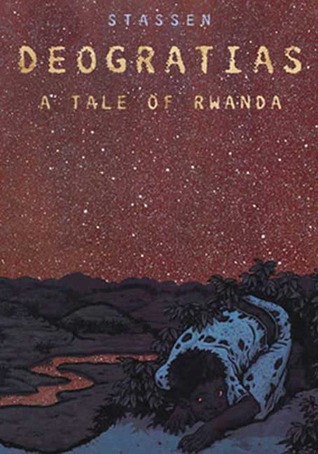 Deogratias: A Tale of Rwanda
Deogratias: A Tale of Rwanda
By J. P. Stassen, translated by Alexis Siegel
($16.95; First Second)
First Second, the latest mainstream publisher’s attempt to push the graphic novel format into the mainstream, made its much-anticipated debut this month with six graphic novels that have been welcomed with the kind of almost-uniformly positive buzz that illustrates the difference having an actual marketing budget, and knowing how to use it, can make. While the long-term sales figures will determine their ultimate success or failure, they’re certainly off to a strong start in the first impression department with superior production values and a wider range of material than their corporate positioning as an imprint of Henry Holt’s Roaring Brook Press children’s division might suggest. Deogratias, in particular, an emotionally harrowing tale of the Rwandan genocide in the mid-90s told from the perspective of the titular Hutu, is as far from a children’s book as you can get.
Leading off with a brief but informative essay about the horrific genocide of nearly one million Tutsi, Rwanda’s minority ethnic group, by the Hutus, the majority, while the superpowers of the world stood by and effectively did nothing, translator Alexis Siegel puts the events into historical context and provides a sturdy foundation for J.P. Stassen’s gut-wrenching tale. Deogratias is a teenage boy with a teenaged boy’s interests, amongst them a fondness for Tutsi girls and Urwagwa (a local banana beer), but when we first meet him, he’s a disheveled drifter who’s been pushed to the edge of madness by what he’s seen and experienced. Stassen takes a risk with the unusual structure of his story, eschewing a linear narrative in favor of switching back-and-forth in time, before and after the massacres, with the only visual cue being the condition of Deogratias’ white clothing. As a result, it’s not immediately clear where the story is going or what’s actually happened that changed him from a happy-go-lucky teen to a delusional drifter who thirsts for Urwagwa and sometimes imagines he’s a dog. While the non-linear structure is confusing at times (a second reading is almost mandatory to fully appreciate it), when it all starts to come together towards the end, it offers the kind of slow reveal gut-punch that sticks with you for days.
Stassen’s visual storytelling is especially strong throughout, and while he avoids focusing on the actual massacres themselves, the couple of key graphic moments he does show will be seared into your brain and effectively punctuate Deogratias’ madness. Beyond those two moments, though, it is his expressive faces and coloring that brings each of his characters to life, from the innocence and determination of Apollinaria and Benina, the Tutsi sisters whose lives are central to Deogratias’ fate, to the culpability of fellow missionaries, Brothers Stanislas and Philip, whose hands are as covered in blood as those of the leaders of the countries who ignored what was happening in Rwanda.
Deogratias proves that graphic novels do not have to simply be escapist entertainment, joining the likes of Maus, Palestine and Persepolis as representatives of more than just great graphic novels, but also as powerful, thought-provoking literature, too. (5 out of 5 Eisners)
[Review originally published by PopCultureShock, 5/15/06]
Do you like email?
Sign up here to get my bi-weekly "newsletter" and/or receive every new blog post delivered right to your inbox. (Burner emails are fine. I get it!)


